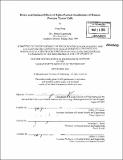Direct and indirect effects of alpha-particle irradiations of human prostate tumor cells
Author(s)
Wang, Rong, Ph. D. Massachusetts Institute of Technology
DownloadFull printable version (10.17Mb)
Other Contributors
Massachusetts Institute of Technology. Dept. of Nuclear Engineering.
Advisor
Jeffrey A. Coderre.
Terms of use
Metadata
Show full item recordAbstract
The objective of this project is to establish a model system to study the direct effect, the bystander effect and the combinational effect of alpha-particle irradiations of human prostate tumor cells, toward the goal of improving the effectiveness of alpha-particle involved radiation therapies such as radioimmunotherapy and BNCT. This project consists of an engineering part and a biological part. In the engineering part, an apparatus for alpha-particle irradiation of cells was designed and constructed. Dosimetry of this irradiator was conducted. The average dose rate to the cell monolayer in the specially designed Mylar dish was calculated to be 1.2 Gy/min. In the biological part, three in vitro studies were carried out with the DU-145 human prostate tumor cells using the established alpha-particle irradiator. Firstly, the direct effects of the alpha-particle irradiation of DU-145 cells were studied using the clonogenic assay, the comet assay and the micronucleus assay. A novel co-culture system was then designed to study the bystander effect transmitted through the cell culture medium. The micronucleus assay was used as endpoint for the bystander studies. A bystander effect was observed. (cont.) Mechanism studies suggested that the nitric oxide was not involved in the process and indicated a short effective lifetime (< min) of the bystander signal. In the combinational studies, the effects of two anticancer drugs (Taxol and Oxaliplatin) together with direct alpha-particle irradiation were studied and no synergistic effect was observed for both drugs. Finally, the combined effect of the bystander effect and drug Taxol was studied, which was the first time that a combined effect between an anticancer drug and the radiation-induced bystander effect was studied. The results of the model studies carried out in the two-dimensional monolayer of cells in this project can serve as a fundamental frame to be further applied to a three dimensional tumor micrometastasis model (spheroids) in the future. The understanding of the role the bystander effect plays in tumor cell killing, its mechanisms and its interaction with other agents, may make it possible to manipulate these factors to improve the effectiveness of alpha-particle involved therapies.
Description
Thesis (Ph. D.)--Massachusetts Institute of Technology, Dept. of Nuclear Engineering, 2005. "September 2005." Includes bibliographical references.
Date issued
2005Department
Massachusetts Institute of Technology. Department of Nuclear Engineering; Massachusetts Institute of Technology. Department of Nuclear Science and EngineeringPublisher
Massachusetts Institute of Technology
Keywords
Nuclear Engineering.